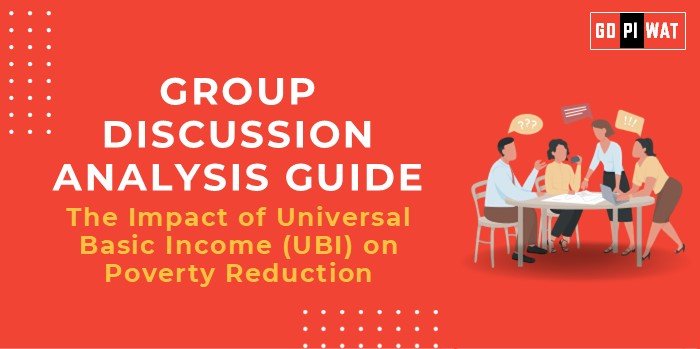📋 Group Discussion Analysis Guide: The Impact of Universal Basic Income (UBI) on Poverty Reduction
🌍 Introduction to UBI
- 💡 Opening Context: Universal Basic Income (UBI) has emerged as a pivotal topic in the global fight against poverty, promising a radical shift in welfare economics by guaranteeing all citizens a fixed, unconditional income.
- 📜 Topic Background: Rooted in 16th-century European utopian thought, UBI gained contemporary traction with pilot programs in Finland (2017-2019) and India’s SEWA trial in Madhya Pradesh. Today, it is explored as a policy response to automation, job insecurity, and inequality.
📊 Quick Facts and Key Statistics
- 🌍 Global Pilots: Finland’s UBI trial showed improved well-being but limited employment effects (2017-2019).
- 🇮🇳 Indian Context: SEWA pilot (2011) resulted in better nutrition, school attendance, and healthcare access.
- 📉 Global Poverty: 9.2% of the world’s population lived below the poverty line ($2.15/day, 2021).
- 💰 Cost of UBI in India: Estimated at 3-4% of GDP for a $50/month scheme.
👥 Stakeholders and Their Roles
- 🏛️ Government: Policymaking and funding UBI schemes.
- 👥 Citizens: Beneficiaries and evaluators of UBI’s societal impact.
- 🤝 NGOs/Think Tanks: Advocacy and implementation trials (e.g., SEWA in India).
- 🌐 Global Bodies: Offering research and funding support (e.g., UN, World Bank).
🏆 Achievements and ⚠️ Challenges
Achievements:
- ✅ Economic Security: UBI alleviates poverty and improves living standards.
- 📈 Administrative Simplicity: Eliminates inefficiencies in targeted welfare programs.
- 📚 Human Capital Development: Improved health and education outcomes (SEWA trial).
Challenges:
- ⚠️ Fiscal Burden: UBI implementation is resource-intensive.
- 📉 Work Disincentives: Concerns about reduced labor force participation.
- 🔍 Targeting Issues: Risk of universal coverage ignoring need-based nuances.
Global Comparisons:
- 🇺🇸 Success: Alaska’s Permanent Fund Dividend (PFD) supports citizens via oil revenues.
- 🇫🇮 Struggles: Finland’s limited economic effects indicate challenges in scalability.
Case Study:
- 🇮🇳 SEWA Pilot in India: Showed a 20% increase in nutrition and 25% better healthcare access among recipients.
📋 Structured Arguments for Discussion
- 📈 Supporting Stance: “UBI is a transformative tool to eradicate poverty and foster economic equity.”
- 📉 Opposing Stance: “UBI poses unsustainable fiscal challenges for developing economies like India.”
- ⚖️ Balanced Perspective: “UBI offers potential but must be complemented with targeted measures and fiscal prudence.”
💡 Effective Discussion Approaches
- 📊 Opening Approaches:
- 📈 “India’s poverty rate could reduce by X% with a $50/month UBI scheme.”
- 📖 “UBI’s ideological roots date back to Thomas More’s Utopia.”
- 🔍 Counter-Argument Handling:
- 💬 Acknowledge fiscal concerns but highlight UBI’s economic multiplier effect.
- 📚 Use evidence from pilot studies to address skepticism about work disincentives.
🔍 Strategic Analysis of Strengths and Weaknesses
- ✨ Strengths: Economic security, reduced inequality, administrative ease.
- ⚠️ Weaknesses: High fiscal cost, potential inflationary impact.
- 🚀 Opportunities: Boosting rural livelihoods, adapting to automation.
- ⛔ Threats: Misuse of funds, political opposition.
📘 Connecting with B-School Applications
- 📚 Real-World Applications:
- 💰 Finance: Sustainable models for funding UBI.
- 🛠️ Operations: Mechanisms for efficient disbursal.
- 💬 Sample Interview Questions:
- 🔎 “Can UBI work as an alternative to existing welfare schemes in India?”
- 🔎 “How would you address UBI’s fiscal constraints in developing economies?”
- ✨ Insights for Students:
- 📊 Explore UBI’s role in ESG investments and fintech applications.
- 📜 Analyze its impact on labor market dynamics.


